These NCERT Solutions for Class 7 Maths Chapter 5 Lines and Angles Ex 5.1 Questions and Answers are prepared by our highly skilled subject experts.
NCERT Solutions for Class 7 Maths Chapter 5 Lines and Angles Exercise 5.1
Question 1.
Find the complement of each of the following angles.
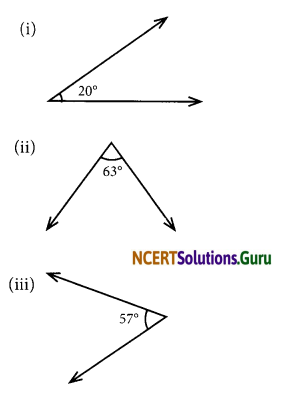
Answer:
(i) Complement of
20° = 90° – 20° = 70°
(ii) Complement of
63° = 90° – 63° = 27°
(iii) Complement of 5 7° = 90° – 57°
= 33°
Quesrion 2.
Find the supplement of each of the following angles:
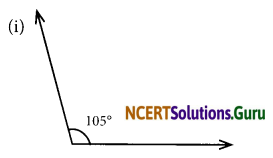
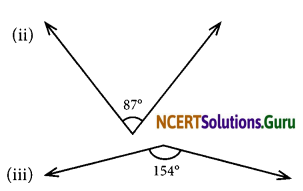
Answer:
(i) Supplement of
105°= 180°- 105° = 75°
(ii) Supplement of
87° = 180° – 87° = 93°
(iii) Supplement of
154° = 180° – 154° = 26°
![]()
Question 3.
Identify which of the following pairs of angles are complementary and which are supplementary.
(i) 65°, 115°
(ii) 63°, 27°
(iii) 112°, 68°
(iv) 130°, 50°
(v) 45°, 45°
(vi) 80°, 10°
Answer:
(i) 65°+ 115°= 180°
65 and 115° are supplementary angles.
(ii) 63°+ 27° = 90°
63 and 27° are complementary angles.
(iii) 112°+ 68°= 180°
112° and 68° are supplementary angles.
(iv) 130° + 50° = 180°
130° and 50° are supplementary angles.
(v) 45° + 45° = 90°
45° and 45° are complementary angles.
(vi) 80° + 10° = 90°
80° and 10° are complementary angles.
Question 4.
Find the angle which is equal to its complement.
Answer:
Let the required angle be x.
Given that the angle is equal to its complement
x = 90° – x
x + x = 90°
2x = 90°
x = \(\frac{90^{\circ}}{2}\) = 45°
Thus, 45° is equal to its complement.
Question 5.
Find the angle which is equal to its supplement.
Answer:
Let the required angle be ‘m’ and supplement of m = 180° – m
∴ m = 180° – m
(∵ m is equal to its supplement)
m + m = 180°
2m = 180°
m = \(\frac{180}{2}\) =90°
Thus, 90° is equal to its supplement.
![]()
Question 6.
In the given figure, ∠1 and ∠2 are supplementary angles.
If ∠1 is decreased, what changes should take place in ∠2 so that both the angles still remain supplementary.
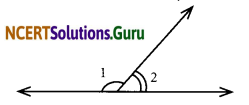
Answer:
In case ∠1 is decreased, the same amount of degree measure is added to ∠2.
i.e. ∠2 be increased by same amount of degree measure.
Question 7.
Can two angles be supplementary if both of them are:
(i) acute?
(ii) obtuse?
(iii) right?
Answer:
(i) Sum of two acute angle is always less than 180°
∴ Two acute angles cannot be supplementary.
(ii) Sum of two obtuse angles is always more than 180°.
∴ Two obtuse angles cannot be supplementary.
(iii) Sum of two right angles =180°
∴ Two right angles can be supplementary.
Question 8.
An angle is greater than 45°. Is its complementary angle greater than 45° or equal to 45° or less than 45°?
Answer:
Complement of an angle (greater than 45°) is less than 45°.
![]()
Question 9.
In the figure given below:
(i) Is∠1 adjacent to ∠2?
(ii) Is ∠AOC adjacent to ∠AOE?
(iii) Do ∠COE and ∠EOD form a linear pair?
(iv) Are ∠BOD and ∠DOA supplementary?
(v) Is ∠1 vertically opposite to ∠4?
(vi) What is the vertically opposite angle of ∠5?
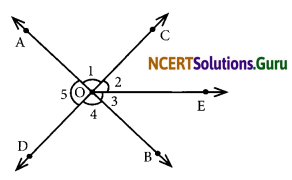
Answer:
(i) Yes, ∠1 and ∠2 are adjacent angles because both the angles have common arm OC and common vertex O.
(ii) No, ∠AOC is not adjacent to ∠AOE because ∠AOC is part of ∠AOE.
(iii) Yes, ∠COE and ∠EOD form a linear pair because COD is a straight line.
(iv) Yes, ∠BOD and ∠DOA are supplementary because ∠BOD + ∠DOA = 180°.
(v) Yes, because AB and CD intersect each other.
(vi) The vertically opposite angle of ∠5 is ∠BOC.
Q1uestion 10.
Indicate which pairs of angles are:
(i) Vertically opposite angles.
(ii) Linear pairs

Answer:
(i) Vertically opposite angles.
In the given figure, the following pairs are vertically opposite angles.
∠1 and ∠4
∠5 and (∠2 + ∠3)
(ii) Linear pairs:
∠4 and ∠5 form a linear pair.
∠1 and ∠5 form a linear pair.
∠1 and (∠3 + ∠2) form a linear pair.
∠4 and (∠3 + ∠2) form a linear pair.
Question 11.
In the following figure, is ∠1 adjacent to ∠2? Give reasons.

Answer:
∠1 and ∠2 are not adjacent angles because they do not have a common vertex.
Question 12.
Find the values of the angles x, y, and z in each of the following:
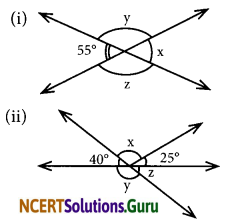
Answer:
(i) Since x and 55° are vertically opposite angles
x = 55°
Also, 55° + y = 180°
(Linear pair)
y = 180°- 55°
y = 125°
since y and z are vertically opposite angles
y = z = 125°
Thus x = 55°, y = 125° and z = 125°
(ii) since 40° and z are vertically
opposite angles
z = 40°
Again y and 40° form a Linear pair
y + 40° = 180°
y = 180°-40°
= 140°
y and (x + 25) are vertically opposite angles
(x + 25°) = y = 140°
∴ x + 25° = 140°
x = 140° -25°= 115°
Thus, x = 115°’ y = 140° and z = 40°
![]()
Question 13.
Fill in the blanks:
Answer:
(i) If two angles are complementary, then the sum of their measures is 90°.
(ii) If two angles are supplementary, then the sum of their measures is 180°.
(iii) Two angles forming a linear pair are supplementary.
(iv) If two adjacent angles are supplementary, they form a linear pair.
(v) If two lines intersect at a point, then the vertically opposite angles are always Equal.
(vi) If two lines intersect at a point, and if one pair of vertically opposite angles are acute angles, then the other pair of vertically opposite angles are obtuse angles.
Question 14.
In the adjoining figure, name the following pairs of angles
(i) Obtuse vertically opposite angles
(ii) Adjacent complementary angles
(iii) Equal supplementary angles
(iv) Unequal supplementary angles
(v) Adjacent angles that do not form a linear pair
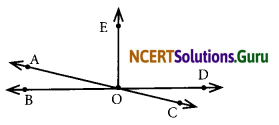
Answer:
(i) ∠BOC and ∠AOD are obtuse vertically opposite angles.
(ii) ∠AOB and ∠AOE are adjacent complementary angles.
(iii) ∠BOE and ∠EOD are equal supplementary angles.
(iv) ∠AOE and ∠EOC are unequal supplementary angles.
(v) (a) ∠BOA and ∠AOE
(b) ∠AOE and ∠EOD
(c) ∠EOD and ∠COD